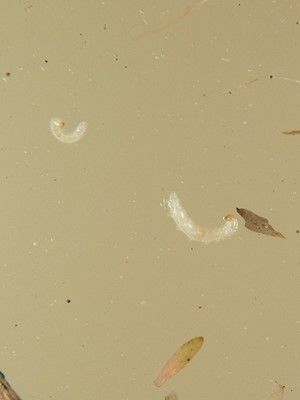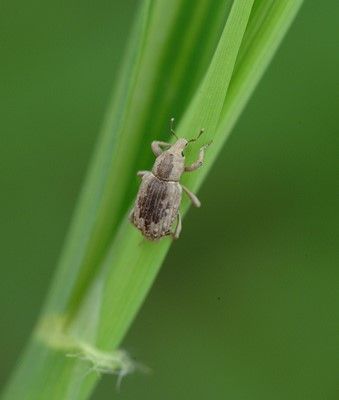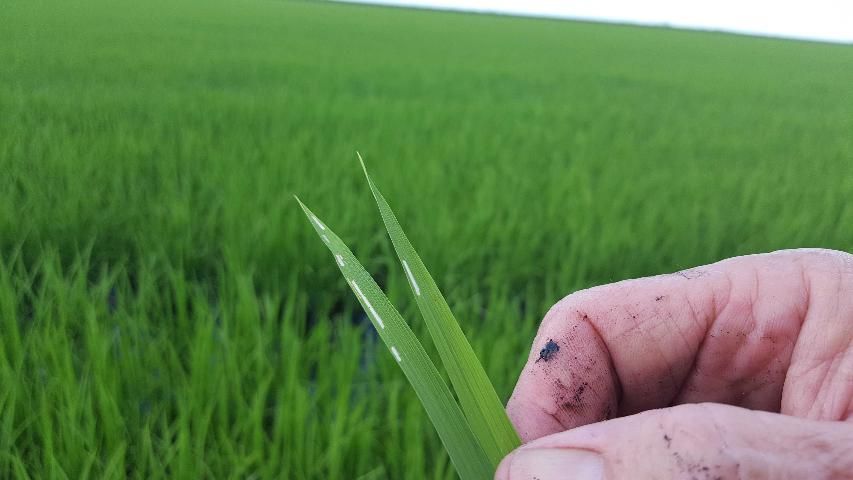Introduction
The rice water weevil, Lissorhoptrus oryzophilus Kuschel, is the most widely distributed and destructive pest of rice, Oryza sativa L., in the United States (Way 1990). The following report provides a description of the rice water weevil, its distribution in the state of Florida, methodology for scouting, and options for managing this pest in commercial rice fields.
Pest Description
The rice water weevil belongs to the family Curculionidae and feeds on a wide variety of plants belonging to the families Poaceae and Cyperaceae (Tindall and Stout 2003, Lupi et al. 2009). While this weevil is a major pest of commercial rice, researchers believe its original host to be wild rice, Zizania aquatica L. (Newell 1913).
Eggs are laid directly into the leaf sheaths of rice plants, just below the water line (Bowling 1972) and hatch after 4-9 days (Raksarat and Tugwell 1975). Newly hatched larvae drop into the soil and move to the roots (Grigarick and Beards 1965). Larval development occurs over four instars (molts) and lasts approximately 28-35 days (Figure 1), though development duration is reduced to 14-21 days in climates of the southern United States (Grigarick and Beards 1965, Cave et al. 1984). Pupation occurs directly on the roots of the rice plant, and adults emerge 5-14 days later (Aghaee and Godfrey 2014). Adults measure approximately 4 mm in length and are light brown (Aghaee and Godfrey 2014) (Figure 2). In the southern United States, multiple generations can occur before adults enter winter diapause (suspended development) (Ingram and Douglas 1930).

Credit: J. Saichuk; used with permission

Credit: J. Saichuk; used with permission
Distribution and Damage
The rice water weevil is native to the southeastern United States and has been reported from all rice-producing states in the United States (Whitehouse et al. 2019). The pest was first reported in Florida in 1916 (Blatchley and Leng 1916) and was noted first occurring on rice grown in Florida in 1979 by Genung et al. (1979). These authors reported the weevil attacking rice at the UF/IFAS Everglades Research and Education Center at Belle Glade, Florida, and, according to C. W. O'Brien, the species' distribution encompassed the entire state (Cherry et al. 2015).
The distribution of rice water weevil injury in rice fields has been shown to vary among different geographic regions. In California, highest populations and most severe injury occur near levee and field margins. Thus, California rice farmers frequently apply insecticides only to these specific areas (Espino 2012). However, in the southern United States, including Florida, weevil populations and injury are distributed more uniformly within fields (Way 2003, Cherry et al. 2013).
There were small but significant differences in the resistance of commercial varieties against rice water weevils. In susceptibility tests in Louisiana, 'Jefferson' was less preferred for oviposition by female adult rice water weevils and 'Jupiter' tended to be the most susceptible variety (Saad et al. 2018). Further tests are needed to determine susceptibility in Florida.
Scouting
Lorenz and Hardke (2015) and Cherry et al. (2016) report that leaf scars caused by adult feeding may be used for scouting purposes to predict the need for control. Fields should be scouted during the first 4 to 7 days after flooding (Figure 3). Injury appears as translucent, longitudinal scars on the leaves (Figure 4). The leaf scar method should be used only during the first two weeks after the permanent flood has been established. Rice water weevil adult feeding scars have been associated with increasing larval infestations (Grigarick and Beards 1965, Tugwell and Stevenson 1974). In Florida, adult weevil leaf scars have a uniform distribution within rice fields, and injury may be overlooked because it is not aggregated on field edges where it is more conspicuous (Cherry et al. 2013). Cherry et al (2016) observed that in Florida there was a significant correlation of feeding injury among fields within a paddy. These data suggest that Florida rice growers may not have to sample all fields in a paddy to estimate weevil injury in the paddy.

Credit: R. Cherry, UF/IFAS

Credit: R. Cherry, UF/IFAS
Rice water weevil larvae may also be sampled to determine the need for control measures. This method may be used to decide on non-chemical management decisions such as draining the field to reduce larval injury and aid in plant recovery. Scouting for larvae should be conducted 2 to 3 weeks after permanent flooding. Sampling involves taking round core samples around rice plants and flotation of the larvae to the surface. Refer to Lorenz and Hardke (2015) for more details on this scouting procedure.
More recently, Hix et al. (2001) reported on trapping adult rice water weevils using aquatic barrier traps. Regression analyses showed a significant correlation between weevil trap catches and subsequent larval infestations. The authors concluded that counts of rice water weevil adults trapped immediately after the permanent flood in drill-seeded fields can be used in decision-making for insecticide applications in rice.
Management
Registered seed and foliar treatments can be applied as preventative control for anticipated economic damage by future weevil populations. Consult your chemical company representative for available treatments. In rice water weevil surveys conducted in Florida by Cherry et al. (2016), control measures would have been justified in only 2% of fields sampled. Only one of the 50 fields sampled exceeded a threshold of 144 damaged plants out of 240 randomly sampled plants within a single field. The varieties of rice sampled were mostly (48%) 'Roy J', as well as 'Cheniere', 'Cocodrie', 'Jupiter', 'Mermentau', 'Taggart', and 'Wells'. As of now, area-wide infestations of rice water weevil in Florida may not be great enough to recommend the use of seed treatment, but fields should be scouted regularly to ensure that populations do not reach damaging levels.
An experimental integrated pest management tool, phytohormonal seed treatments, have been widely tested (Kraus and Stout 2019). They are used to induce the plant's defenses to potentially reduce pest feeding injury, promote natural biological control by induction of volatile organic compounds, and "reduce environmental contamination. However, in field tests, phytohormones performed no better paired with chemical foliar treatment alone than the foliar treatment due to negative plant growth effects.
Manipulating the planting date has been suggested as a cultural control tactic for rice water weevils. Early-planted rice has been shown to be less susceptible to yield reductions from weevil feeding (Thompson et al. 1994) and can serve as an important component in a management program (Stout et al. 2011). However, other studies have concluded that early planting of rice may in fact increase or have no effect on yield reductions (Tarpley et al. 2008, Espino et al. 2009). In Florida, an increase in adult feeding damage was observed as the rice season progressed (Cherry et al. 2016).
In most rice-growing regions around the world, rice is grown as a lowland crop where the soil is flooded for a majority of the season. Application of this permanent flood is the most important external influence on the interaction between the rice water weevil and rice (Stout et al. 2002). Reports on the effect of flood depth on rice water weevil populations have been inconsistent (Rolston and Rouse 1964; Stout et al. 2002, 2014; Bernhardt 2007). Shang et al. (2004) noted that rice water weevil biology may differ among rice-producing areas and that methods used for management in one region may not apply in another. Cherry et al. (2015) demonstrated that shallow flooding reduced rice water weevil populations in Florida rice but sweep net data showed that flood depth had little, if any, effect on four groups of above-water arthropods: damselflies (Order: Odonata), leafhoppers (Family: Cicadellidae), spiders (Order: Araneae), and stink bugs (Family: Pentatomidae).
References
Aghaee, M., and L. D. Godfrey. 2014. A century of rice water weevil (Coleoptera: Curculuionidae): a history of research and management with an emphasis on the United States. J. Integ. Pest Mngmt. 5: 1–14.
Bernhardt, J. 2007. Influence of flood depth on rice water weevil infestation and damage, pp. 99?102. In Norman, R. J. Meullenet, and K. Maldenhaur (eds.) B. R. Wells Rice Research Studies. University of Arkansas, Fayetteville.
Blatchley, W., and C. Leng. 1916. Rhynocophora or weevils of North Eastern America. Nature Publ. Co. Indianapolis, IN.
Bowling, C. C. 1972. Note on the biology of rice water weevil Lissorhoptrus oryzophilus. Ann. Entomol. Soc. Am. 65: 990–991.
Cave, G. L., C. M. Smith, and A. F. Robinson. 1984. Population dynamics, spatial distribution, and sampling of the rice water weevil on resistant and susceptible rice genotypes. Environ. Entomol. 13: 822–827.
Cherry, R., B. Sakr, L. Trotta, and G. Nuessly. 2013. Distribution of rice water weevil (Coleoptera: Curculionidae) adult damage in Florida rice fields. J. Entomol. Science. 48: 265–269.
Cherry, R., M. Tootoochi, J. Bhadha, T. Lang, M. Karounos, and S. Daroub. 2015. Effect of flood depth on rice water weevil (Coleoptera: Curculionidae) populations in Florida rice fields. J. Entomol. Sci. 50: 311–317.
Cherry, R., M. Karounos, and B. Sakr. 2016. Rice water weevil (Coleoptera: Curculionidae) damage in Florida rice fields. J. Entomol. Science. 51: 219–225.
Espino, L. 2012. Occurrence and abundance of Lissorhoptrus oryzophilus (Coleoptera: Curculionidae) relative to field borders in California rice. Fla. Entomol. 95: 445–453.
Espino, L., M. Way, R. Pearson, and M. Nunez. 2009. Effect of planting date on Lissorhopterus oryzophilus (Coleoptera: Curculionidae) density yield relationship on rice in southeastern Texas. J. Econ. Entomol. 102: 1536–1545.
Genung, W., G. Snyder, and C. Green. 1979. Rice field insects in the Everglades. Belle Glade Res. Rep. EV. 1979–7. Univ. of Florida.
Grigarick, A. A., and G. W. Beards. 1965. Ovipositional habits of the rice water weevil in California as related to a greenhouse evaluation of seed treatments. J. Econ. Entomol. 58: 1053–1056.
Hix, R., D. Johnson, and J. Bernhardt. 2001. Trapping adult Lissorhoptrus oryzophilus (Coleoptera: Curculionidae) with aquatic barrier traps. Environ. Entomol. 30: 770–775.
Ingram, J. W., and W. A. Douglas. 1930. Damage by the rice water weevil proved negligible. La. Agric. Exp. Station Bull. 214: 5–8.
Kraus, E. C., and M. J. Stout. 2019. Seed treatment using methyl jasmonate induces resistance to rice water weevil but reduces plant growth in rice. PloS one. 14.
Lorenz, G., and J. Hardke. 2015. Insect management in rice, pp. 139–162. In J. Hardke (eds.), Arkansas rice production handbook. MP 192. Univ. Arkansas Div. Agric., Fayetteville, Arkansas.
Lupi, D. L., C. C. Cenghialta, and M. C. Colombo. 2009. Adult feeding by the rice water weevil Lissorhoptrus oryzophilus on different host plants. Bull. Insectol. 62: 229–236.
Newell, W. 1913. Notes on the biology of rice water weevil (Lissorhoptrus simplex Say) and its control. J. Econ. Entomol. 6: 55–61.
Raksarat, P., and P. Tugwell. 1975. Effect of temperature on development of rice water weevil eggs. Environ. Entomol. 4: 543–544.
Rolston, L., and P. Rouse. 1964. Some factors influencing larval infestations of the rice water weevil. J. Kansas Entomol. Soc. 37: 29?35.
Mohamad Saad, M., Rahaman, M. M., and M.J. Stout. 2018. Varietal resistance against the rice water weevil in field and greenhouse studies. Environ. Entomol. 47: 388–395.
Shang, H., M. Stout, Z. Zhang, and J. Cheng. 2004. Rice water weevil (Coleoptera: Curculionidae) population dynamics in Louisiana. J. Entomol. Science. 39: 623–642.
Stout, M., M. Rigio, L. Zou, and R. Roberts. 2002. Flooding influences ovipositional and feeding behavior of the rice water weevil (Coleoptera: Curculionidae). J. Econ. Entomol. 95: 715–721.
Stout, M., N. Hummel, M. Frey, and W. Rice. 2011. The impact of planting date on management of the rice water weevil in Louisiana rice. The Open Entomol. J. 5: 1–9.
Stout, M., N. Hummel, S. Lanka, J. Hamm, A. Mészáros, W. McClain, M. Frey, and G. Barbee. 2014. Rice water weevils – new tactics for managing this insect pest. pp. 1–3. 22 June 2014. www.lsuagcenter.com
Tarpley, L., J. Stansel, and M. Jund. 2008. Planting dates, pp. 8–9. In 2008 Texas rice production guidelines. Tex. Agric. Exp. Stn. B-6131.
Thompson, R., S. Quisenberry, F. Guessan, A. Heagler, and G. Giesler. 1994. Planting date as a potential cultural method for managing the rice water weevil (Coleoptera: Curculionidae) in water-seeded rice in southwest Louisiana. J. Econ. Entomol. 87: 1318–1324.
Tindall, K. V., and M. J. Stout. 2003. Use of common weeds of rice as hosts for the rice water weevil (Coleoptera: Curculionidae). Environ. Entomol. 32: 1227–1233.
Tugwell, P., and T. Stevenson. 1974. Possible scouting procedures for rice water weevil, p. 41. Proc. 15th Rice Tech. Working Group. 91 pp.
Way, M. 1990. Insect management in rice in the United States, pp. 181?189. In B. Grayson, M. Green, and L. Copping (eds.), Pest management in rice. Elsevier Science Publ. Co. Inc. New York.
Way, M. 2003. Rice arthropod pests and their management in the United States, pp. 437–457. In C. Smith and R. Dilday [eds.], Rice – origin, history, technology, and production. John Wiley and Sons, Inc. Hoboken, NJ.
Whitehouse, R., Thrash, B., Lorenz, G., and N. Bateman. 2019. First report of rice water weevil, Lissorhoptrus oryzophilus, in grain sorghum in the United States. J. Agric. Urban Entomol. 35: 36–40.